
Chronic kidney disease (CKD) is a major cause of mortality and decreased quality of life in both cats and dogs. Although the prevalence of chronic kidney disease (CKD) is estimated to be 0.5% to 1% in dogs and 1% to 3% in cats, the risk surges up to 30% to 50% in older animals. Alongside traditional kidney function biomarkers, such as blood urea nitrogen and creatinine, symmetric dimethylarginine (SDMA) has recently received significant attention in veterinary medicine. Due to its exceptional sensitivity, reliability, and detectable elevation in the early onset of the disease, symmetric dimethylarginine (SDMA) offers unique advantages for diagnostic testing and preventive screening of kidney disease and other associated conditions. Providing prompt and clinically actionable results for all patients, symmetric dimethylarginine (SDMA) tests assist the early diagnosis and effective management of chronic kidney disease (CKD). Read along to learn more about symmetric dimethylarginine (SDMA) and how its level is tested to assist in the diagnosis of chronic kidney disease (CKD) in cats and dogs.
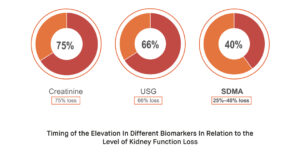
How Does Chronic Kidney Disease Develop in Cats and Dogs?
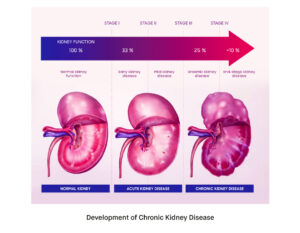
In cats and dogs, chronic kidney disease (CKD) is defined as an impairment in the function or structure of the kidneys that lasts for more than three months. While not always present, clinical signs associated with chronic kidney disease (CKD) include increased thirst, appetite loss, vomiting, urination, lethargy, and bad breath. Unfortunately, nephron damage caused by chronic kidney disease (CKD) is largely irreversible and typically progressive. In fact, chronic kidney disease (CKD) is evaluated under different stages depending on blood creatinine levels, blood symmetric dimethylarginine (SDMA) levels, blood pressure measurement, and urine protein levels. Still, the majority of the mechanisms with known links to kidney disease progression, such as nephrocalcinosis, systemic hypertension, intraglomerular hypertension, and proteinuria, are potentially treatable upon prompt diagnosis.
What Is Symmetric Dimethylarginine (SDMA)?
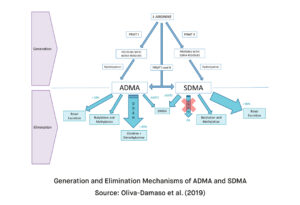
Symmetric dimethylarginine (SDMA) is a methylated form of arginine in intracellular proteins of all nucleated cells. It is produced by all nucleated cells at a constant rate and released into circulation as intracellular proteins are processed. Functioning as an inhibitor of nitric oxide synthase, symmetric dimethylarginine (SDMA) is thought to promote the production of reactive oxygen species in cats, dogs, and humans. Around 90% of symmetric dimethylarginine (SDMA) is excreted by glomerular filtration in the kidneys. While there is some evidence of liver uptake in humans, symmetric dimethylarginine (SDMA) is not reabsorbed in renal tubules or influenced by the majority of known non-renal factors. Since it accumulates shortly in patients with renal failure, a level of symmetric dimethylarginine (SDMA) correlates strongly with glomerular filtration rate (GFR), and an elevated level of symmetric dimethylarginine (SDMA) indicates impaired renal function in humans, dogs, and cats. Accordingly, symmetric dimethylarginine (SDMA) is accepted as a biomarker for many different renal conditions, such as chronic kidney disease (CKD), acute kidney injury, pyelonephritis, upper urinary obstruction, kidney stones, glomerulonephritis, congenital disease. In addition, it can reflect various other conditions such as hyperthyroidism, vector-borne diseases, systemic hypertension, cardiorenal syndrome, sepsis, cancers, and drug toxicity.
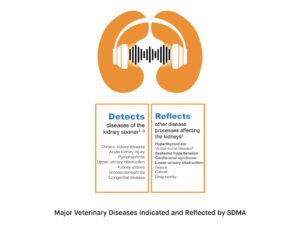
What are the Advantages of SDMA Testing?
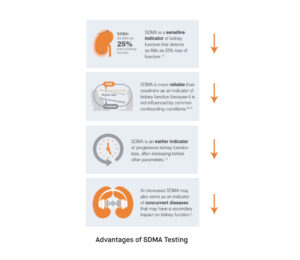
Alongside symmetric dimethylarginine (SDMA), blood urea nitrogen and creatinine are the most common indicators of kidney function. Urea is produced during the breakdown of ammonia from the liver after the digestion of proteins, while creatinine is produced during the breakdown of muscle cells. Similar to symmetric dimethylarginine (SDMA), both substances are largely excreted by the kidneys via filtration. However, no elevation in the concentration of either blood urea nitrogen or creatinine is detectable until the kidneys lose around 70% of their filtration ability. In contrast, the level of symmetric dimethylarginine (SDMA) in blood or serum begins to increase as early as 30 to 40% loss of kidney function. Therefore, symmetric dimethylarginine (SDMA) proves to be a more sensitive and earlier biomarker relative to both blood urea nitrogen and creatinine. Moreover, symmetric dimethylarginine (SDMA) is also much less affected by the diet, health status, size, and age of the tested animal. Whereas a high protein diet and exercise can cause a temporary rise in urea level, loss of lean muscle mass can cause low to normal levels of creatinine to be detected in the blood. As its concentration is unaffected by these factors, symmetric dimethylarginine (SDMA) demonstrates high reliability in all tested patients.
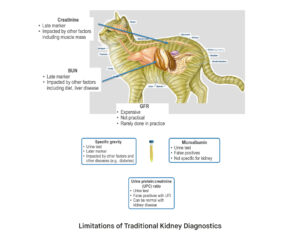
How Is the SDMA Test Used to Identify Chronic Kidney Disease?
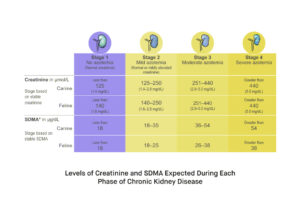
The majority of the SDMA tests available for use with canine and feline specimens are ELISA tests designed for the quantitative determination of symmetric dimethylarginine (SDMA) in serum or plasma samples. The kit utilizes symmetric dimethylarginine (SDMA) that is bound to the solid phase of a microtiter plate to determine the level of symmetric dimethylarginine (SDMA) in the collected sample. The acylated symmetric dimethylarginine (SDMA) in the collected sample competes with solid phase bound symmetric dimethylarginine (SDMA) for a fixed number of anti-SDMA antiserum binding sites. If the system is in equilibrium, free antigen and free antigen-antibody complexes are removed by washing. Otherwise, the antibodies bound to the solid phase SDMA is determined, and their amount is evaluated in inverse proportion to inform on the concentration of symmetric dimethylarginine (SDMA) within the tested sample. An elevated level of symmetric dimethylarginine (SDMA) is correlated with the impairment of glomerular filtration rate (GFR) and is an early indicator of chronic kidney disease (CKD).
